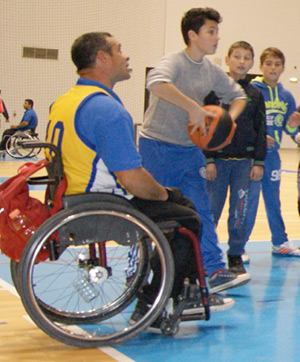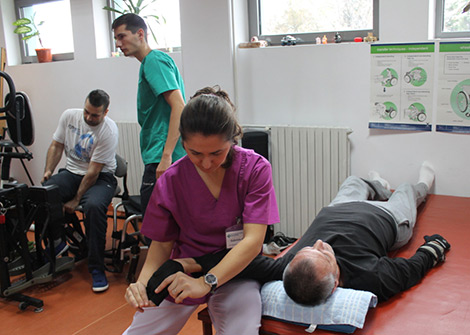
MRF held two successful wheelchair basketball events in cooperation with World Vision Romania. During the first event on November 10, 2014, more than 150 school children participated, some of who played basketball with the coach and wheelchair athletes after the match. Source: MRF, 2015
The Accelerating Core Competencies for Effective Wheelchair Service and Support (ACCESS) project is a $9 million, USAID-funded project implemented in Kenya, India, Romania, Nicaragua, and El Salvador. The overall project goal is to mobilize World Vision’s long-term local presence in these countries and to strengthen the wheelchair sector. The project will help to ensure that all people with mobility limitations, especially women and children, are able to access appropriate products through qualified service providers and fully participate in their communities.
The ACCESS project is helping to address the issue of development organizations too often distributing wheelchairs without proper assessment, fitting, or follow-up as outlined in the World Health Organization (WHO) Guidelines. Service providers are unaware of the Guidelines and untrained on wheelchair provision. Wheelchair users are not integrated into their communities.
Project Objectives
- Foster an enabling environment toward effective wheelchair service and management through stakeholder engagement and mobilization and local and national-level advocacy efforts.
- Expand wheelchair service provision in all five project countries by diversifying the range of available products and bolstering the management and service capacity of local organizations.
- Deliver the Basic and Intermediate Wheelchair Service Training Packages (WSTP) to wheelchair service personnel to increase the human resource capacity for quality wheelchair service delivery in each country.
The Access Partnership and Model
To achieve the project goal, World Vision has partnered with ten organizations across the five project countries. Motivation Charitable Trust, United Cerebral Palsy – Wheels for Humanity, and the Motivation Romania Foundation (MRF) provide technical support and expertise in wheelchair provision. These organizations build the capacity of local partners to undertake proper wheelchair provision by providing training, equipment, supplies, and ongoing mentorship throughout the program. Through this partnership, World Vision provides the community-based identification, social inclusion, follow-up, and supported and trained service providers to conduct the hands-on wheelchair provision.
Following the ACCESS model within Area Development Programs (ADPs), World Vision will identify those in need of wheelchairs and conduct a referral screening and brief interview about the client’s current barriers to social inclusion. ADP staff will enter client intake data into the ACCESS database and refer the client to a local ACCESS service provider. The service provider will conduct the clinical assessment, prescribe a wheelchair as needed, and do the fitting and user training. World Vision staff will follow up immediately and every six months thereafter to include the client in the life of the ADP and determine user satisfaction. In areas outside of World Vision’s influence, partner service providers may identify potential clients and then conduct all intake and follow-up as well as link clients with social inclusion activities in their communities.
In addition, ADPs will work with communities and disabled people’s organizations (DPOs) to run Citizen Voice and Action (CVA), World Vision’s proven advocacy methodology, to promote disability inclusion. At the end of the project, ADP staff and service providers will re-interview all clients to determine whether barriers to social inclusion have been lifted due to wheelchair provision and deliberate efforts to include clients into the life of their communities.
Including Wheelchair Users in the Life of the ADP

Participants in the Active Rehabilitation and Life Skills Training Program organized by MRF in November 2014 received individual physical therapy sessions. In the foreground, MRF physical therapist is assisting a tetraplegic wheelchair user during a physical exercise for improving his mobility. Source: MRF, 2015
World Vision ADPs work with communities to address the root causes of poverty and injustice together, especially for the most vulnerable. People with mobility disabilities are often limited in their social inclusion due to lack of access to activities, social stigma, or lack of awareness. By involving wheelchair users in the life of the ADP, they can use their time and talents to strengthen the community.
Wheelchair users can be included in the life of the ADP by:
- Providing them with information about current ADP programs
- Inviting them to participate in ADP activities
- Locating ADP activities in wheelchair accessible locations
- Identifying community members to assist wheelchair users to attend meetings and events
Progress and Milestones
As of December 31, 2014, the ACCESS project has accomplished the following under each of the project objectives:
Objective 1: Fostering an Enabling Environment
Stakeholder identification and sensitization continues in all five project countries with commitment confirmed on a rolling basis. Stakeholders on this project include ministries of health and/or ministries of social welfare, churches, educators, and DPOs. These stakeholders play a key role in the referral network for those in need of wheelchair service and in advocacy.
CVA groups are being formed and/or identified. Where CVA groups exist, those groups are being educated on disability issues. Where there are active DPOs, they are being educated on CVA methodology. In some locations new CVA groups are being formed for this project. Further work on sensitization on disability inclusion as well as CVA methodology trainings are necessary before CVA work can being in earnest.
Objective 2: Expanding Wheelchair Provision and Capacity
So far 282 clients have received wheelchairs under the ACCESS project (114 men and 88 women). The majority of these wheelchairs were provided during training events as demonstrations. However, now that the first round of trainings has been completed wheelchair provision is expected to increase rapidly.
The technical experts have conducted the first service assessments to determine a baseline quality of wheelchair service and develop capacity building work plans for each local service center. These work plans will inform the mentorship, equipment, supplies, and training provided to local organizations as they build their capacity at wheelchair provision. By the end of 2014 the project had built the capacity of 14 organizations.
Objective 3: Provide Training to Wheelchair Service
So far the ACCESS project has trained 202 people across the five project countries. Of these, 90 received basic training. This training uses the WHO WSTP basic curriculum which instructs participants on providing proper wheelchair service to those who need a basic-level wheelchair, one without extra postural support. 80 managers have been trained on what constitutes proper wheelchair services through the WSTP managerial curriculum. Thirty-two wheelchair users have been provided peer group independent or active rehabilitation training.
Next Steps for ACCESS
In the coming year, the ACCESS project will ramp-up wheelchair provision, organizational capacity building, and service provider training. In addition, World Vision will incorporate wheelchair users into ADP activities and follow up on services. The ACCESS model of proper wheelchair provision and community follow-up will be promoted across the World Vision partnership.
